The first page opened with a poem titled "Spring,” followed by "How a Pawnee Got Ahead of a Cheyenne Chief: A Story as told by one of our Boys," in which a U.S. congressman’s position was chastised using an analogy of a Cheyenne-Pawnee skirmish. There is also a blurb about temperance on this page. Page two featured many small news items…
Distributing Photographs of the School and Students
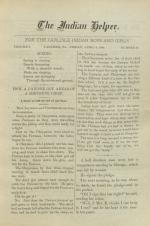
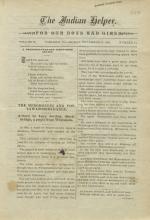
The first page opened with a poem titled "A Fourteen-Year-Old Girl's Good Advice," followed by an article called "The Menomonees and Pottawatomies Dance: A Story by Lucy Jordan, Stockbridge, a pupil from Wisconsin," that told of an 1882 visit by dancers to her home agency in Keshena, Wisconsin. Page two included an offer of photographs for new…
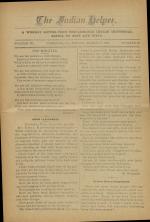
The first page opened with a poem, "The Minutes," followed by Marianna Burgess' letter "From California," to the Man-on-the-Band-Stand describing idyllic weather compared to what she's hearing of blizzard conditions at the school. The second page began with an account of the visit and talk by Mr. Kanzo Uchumiura, a Japanese student visiting the…
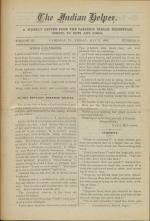
The first page opened with a poem "Work a Blessing," followed by a letter "To the Republic Debating Society," from Nancy McIntosh (Creek) reporting her position as teacher in Eufala, Indian Territory. The last article on this page was entitled "Curiosity," which continued on page four. Page two listed many small news items about returned…

The first page opened with an untitled poem that bore the first line, “No human life ere dawned on earth.” Then came an article titled “Judge Wright’s Talk,” that excerpted J.V. Wright’s discourse on the importance of the Indian students’ perseverance and the success of the Coeur d’Alene and Chippewa nations. The talk continued on page four.…
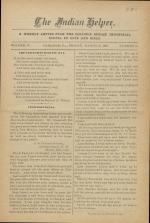
The first page opened with a poem "The Voice That Wins Its Way" contributed by Hannah E. Wilson, followed by a piece called "From John Dixon" which was reprinted from the Albuquerque Indian School where Dixon (Pueblo) was employed as a carpenter and translator for Indian school recruitment. The article continued on page four. Page two offered “…
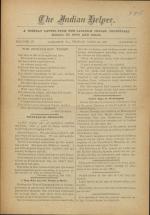
The first page opened with a poem "The Printer-Boy Tramp” by Will Carleton, followed by “Encouraging Prospects” about Luther Kuhns at the Pawnee Agency. Next came “A Man Who was not Afraid to Work” on how General Washington set an example for his corporal. Also on the page was an article titled “Easter Eggs in Washington.” Page two contained a…
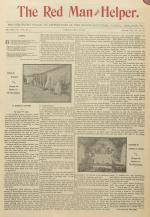
A description of this document is not currently available.
Note: This issue was also published as The Red Man (Vol. 16, No. 4) and Helper (Vol. 15, No. 37).

Samuel Chapman Armstrong of the Hampton Institute sends Richard Henry Pratt encouragement ahead of a recruitment trip to the West, and suggests using photographs from Hampton to help in his efforts.
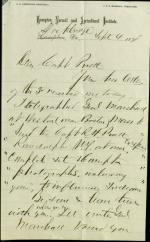
Samuel Chapman Armstrong writes to Richard Henry Pratt informing him that he telegraphed instructions for Pratt to be sent a complete set of Hampton Institute photograph to be used in his recruitment efforts. At this time, Pratt was preparing or had already left on a recruitment trip. Armstrong also notes that he sent a photograph to Spotted…
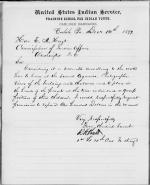
Richard Henry Pratt requests authority to spend $100 to take photographs of the buildings and students, both individually and in groups, to send to Indian agencies and the students' parents.
Note: This item was copied from U.S. National Archives microfilm reels (M234), which were filmed from the original documents found in Record Group…
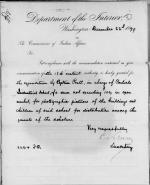
Secretary of the Interior Carl Schurz grants permission for Captain Richard H. Pratt to spend $100 on taking photographs of Carlisle Indian School buildings and students to send to the students' parents.
Note: This item was copied from U.S. National Archives microfilm reels (M234), which were filmed from the original documents found in…
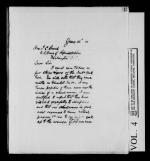
Pratt writes to Rep. Thaddeus C. Pound, sending him stereoviews of the students and providing information about their progress at the school. He notes that now that the work of the schoolroom is successfully underway they will begin fitting up the industrial shops. He observes that by selling the products of the school's industrial program to…
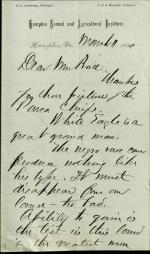
Samuel Chapman Armstrong of the Hampton Institute writes to Richard Henry Pratt thanking him for photographs of visiting Ponca chiefs at Carlisle, discussing aspects of their visit and Armstrong's fundraising attempts for a new building.
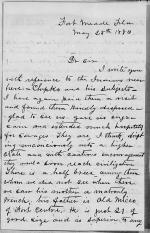
George W. Hendry informs Richard Henry Pratt that he knows a 21 year old man, who's half Indian and half Black, who is "dignified" and can speak English. He asks Pratt to send him pictures of Indian students and schools. Pratt forwards Hendry's letter to the Commissioner of Indian Affairs and informs him that he did send Hendry the pictures.…
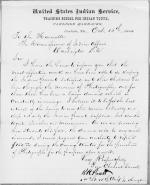
Richard Henry Pratt describes the benefits of photography in assuaging parents' fears of sending and keeping their children at the Carlisle Indian School and believes that it would be similarly beneficial to send photographs to Indian agents, teachers, and missionaries. As such, Pratt requests to spend $150 on photographs.
Note: This…
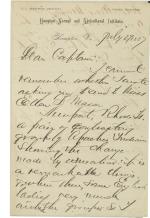
Samuel Chapman Armstrong of the Hampton Institute writes to Richard Henry Pratt asking him to send a pair of photographs showing "contrasting groups of Apache Indians" to Miss Ellen F. Mason on Newport, Rhode Island, who wished to share them with her English friends.
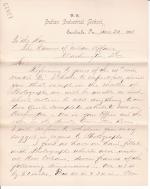
Richard Henry Pratt responds to an Office of Indian Affairs letter regarding an upcoming exhibit in Cincinnati. He notes that Carlisle cannot add to the exhibits currently in Washington D.C. at the Office of Indian Affairs and Senate Committee Room on short notice with the exception of some photographs of which he includes various size frames…
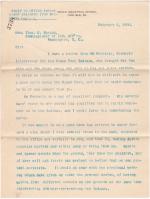
Richard Henry Pratt writes to the Office of Indian Affairs regarding bringing a party of students from the Blackfeet Agency. In addition, he discusses his plan to have agents organize parties of students, because their knowledge of the individuals involved can better protect the school if they act fairly. Pratt then provides his guidelines for…
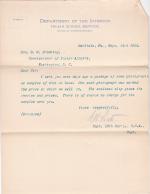
Richard Henry Pratt forwards a list of photographs available for purchase at the Carlisle Indian School.
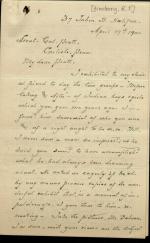
R. F. Armstrong writes Richard Henry Pratt asking for additional copies of the Before and After photographs he previously received, and describes a friend's experiences and perspective when gifted Armstrong's original copies. Armstrong also encourages Pratt not to get involved with "the Negro question" and discusses his views towards education…
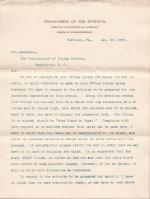
J. R. Wise responds to an Office of Indian Affairs letter regarding the Jamestown Exposition. Wise provides a list of articles to be provided by the Carlisle Indian School as well as building the exhibition cases. In addition, Wise states that the Johnston photographs can be used along with newer photos along with Native work from Angel De Cora…
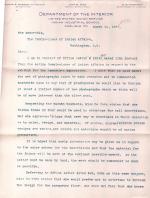
William A. Mercer requests early information regarding the Jamestown Exposition Indian Office exhibit. Mercer requests to be allowed to use newer photographs in addition to those taken by Frances Benjamin Johnston along with using Navajo blankets to decorate the wall.
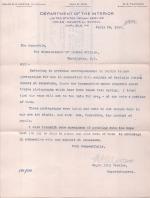
William A. Mercer informs the Office of Indian Affairs newly produced photographs taken by students at the Carlisle Indian School along with items from the printing department for the exhibit at the Jamestown Exposition have been forwarded to their Office.
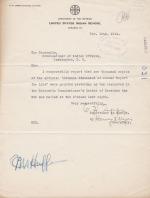
This material includes a request the Louis Lange Publishing Company, publishers of the German magazine Abendschule, for information about the history of the Carlisle Indian School. This information, along with a list of further readings and some photographs, were supplied by the Assistant Commissioner of Indian Affairs.
Also…
